Neuro-Chip from Infineon Can Read Your Mind - New Findings in Brain Research Expected
Munich, February 11, 2003 – Infineon Technologies announces a breakthrough development for neurological science by means of a biosensor chip. Researchers at Infineon and the Max Planck Institute managed to record and process the electrical signals from nerve cells, so-called neurons, as exactly as never before. The “Neuro-Chip” amplifies the signals and transfers them to a computer system for processing. This innovation is a promising development for researchers who expect to gain new insight into the neuron jungle that forms the human brain. Here, more than 100 billion nerve cells are continuously exchanging information. Knowledge of their principle of operation and interaction could be a first step toward solving diseases to the brain which are still incurable today.
The nerve cell signals are read on the chip by means of sensors below which a sophisticated electronic circuit is integrated to amplify and process the extremely weak electrical signals (5 millivolts maximum) of the neurons. These are applied on the sensor array so that each nerve cell covers at least one sensor. This is possible because the spacing of the sensors, at eight thousandth of a millimeter, is smaller than the diameter of a neuron (10 to 50 thousandths of a millimeter). A total of 16,384 high-sensitivity sensors are contained in a chip area of one square millimeter. Each sensor is capable of recording at least 2,000 values per second.
Based on this data, neurobiological researchers can analyze how associated cell groups or individual cells respond to electrical stimulation or specific substances over a defined period of time. For instance, in order to study the interaction between cells of different areas of the brain, it is possible to apply individual nerve cells and to grow them into neural networks on the sensor array. The cell tissue is not damaged in this process and can be kept alive over a period of several weeks.
Infineon’s Neuro-Chip provides scientists with a long-awaited tool for doing enabling research. The undisturbed observation of nerve tissue over a long period offers neurobiological and neurochemical researchers a continuous insight into the functionality of the memory. The Neuro-Chip may provide new findings to support the understanding of how information is perceived, processed and stored in the brain.
Initial successful measurements with the Neuro-Chip were conducted on snail brain cells at the Max Planck Institute (MPI) in Martinsried near Munich, Germany. The MPI team headed by Professor Peter Fromherz has accompanied the research as scientific project partner of Infineon. “That our long-lasting basic research on neuron-semiconductor interfaces now sees a high-tech chip, is like a dream coming true. Infineon's development of cutting edge microelectronics may be a pre-condition for unheard of applications in the field of biomedicine, biotechnology and brain research,” says Fromherz.
The newly announced sensor chip is part of an overall project in the field of biotechnology at Infineon. The chip manufacturer was able to present the world’s first biochip with integrated electronics for evaluation and analysis of molecular-scale samples in 2002, after announcing a chip that used an optical evaluation technique one year earlier.
More than 32 million information values per second
The nerve cell signals are read on the chip by means of sensors below which a sophisticated electronic circuit is integrated to amplify and process the extremely weak electrical signals (5 millivolts maximum) of the neurons. These are applied on the sensor array so that each nerve cell covers at least one sensor. This is possible because the spacing of the sensors, at eight thousandth of a millimeter, is smaller than the diameter of a neuron (10 to 50 thousandths of a millimeter). A total of 16,384 high-sensitivity sensors are contained in a chip area of one square millimeter. Each sensor is capable of recording at least 2,000 values per second.
Based on this data, neurobiological researchers can analyze how associated cell groups or individual cells respond to electrical stimulation or specific substances over a defined period of time. For instance, in order to study the interaction between cells of different areas of the brain, it is possible to apply individual nerve cells and to grow them into neural networks on the sensor array. The cell tissue is not damaged in this process and can be kept alive over a period of several weeks.
Infineon’s Neuro-Chip provides scientists with a long-awaited tool for doing enabling research. The undisturbed observation of nerve tissue over a long period offers neurobiological and neurochemical researchers a continuous insight into the functionality of the memory. The Neuro-Chip may provide new findings to support the understanding of how information is perceived, processed and stored in the brain.
Partnership with Max Planck Institute
Initial successful measurements with the Neuro-Chip were conducted on snail brain cells at the Max Planck Institute (MPI) in Martinsried near Munich, Germany. The MPI team headed by Professor Peter Fromherz has accompanied the research as scientific project partner of Infineon. “That our long-lasting basic research on neuron-semiconductor interfaces now sees a high-tech chip, is like a dream coming true. Infineon's development of cutting edge microelectronics may be a pre-condition for unheard of applications in the field of biomedicine, biotechnology and brain research,” says Fromherz.
The newly announced sensor chip is part of an overall project in the field of biotechnology at Infineon. The chip manufacturer was able to present the world’s first biochip with integrated electronics for evaluation and analysis of molecular-scale samples in 2002, after announcing a chip that used an optical evaluation technique one year earlier.
About Infineon
Infineon Technologies AG, Munich, Germany, offers semiconductor and system solutions for the automotive and industrial sectors, for applications in the wired communications markets, secure mobile solutions as well as memory products. With a global presence, Infineon operates in the US from San Jose, CA, in the Asia-Pacific region from Singapore and in Japan from Tokyo. In fiscal year 2002 (ending September), the company achieved sales of Euro 5.21 billion with about 30,400 employees worldwide. Infineon is listed on the DAX index of the Frankfurt Stock Exchange and on the New York Stock Exchange (ticker symbol: IFX). Further information is available at www.infineon.com.
Information Number
INFCPR200302.042e
Press Photos
-
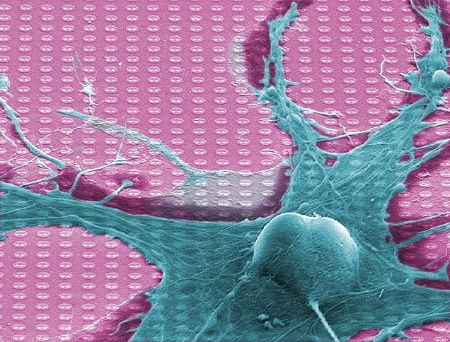 The "Neuro-Chip" from Infineon Technologies is connected with a living nerve cell. The Neuro-Chip's 16,384 sensors read the electrical activity of the cell. The typical size of neurons is between 10 - 50 micrometers (1 µm, a thousandth of a millimeter). Press Photo: Infineon Technologies, Max Planck InstitutePress Picture
The "Neuro-Chip" from Infineon Technologies is connected with a living nerve cell. The Neuro-Chip's 16,384 sensors read the electrical activity of the cell. The typical size of neurons is between 10 - 50 micrometers (1 µm, a thousandth of a millimeter). Press Photo: Infineon Technologies, Max Planck InstitutePress PictureJPG | 313 kb | 636 x 484 px
-
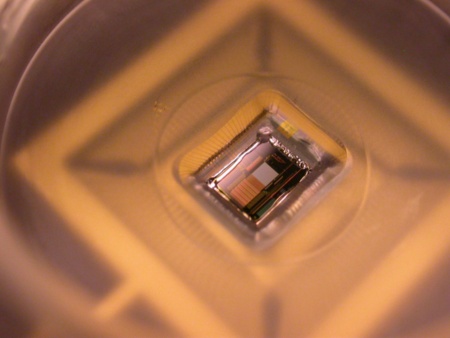 Microscopic zoom on the Neuro-Chip makes visible the sensor grid of 1 millimeter x 1 millimeter and the circuitry above which enables to record, amplify and process the more than 32 million information bytes presented by the 16,384 sensors on the grid every second. Press Photo: Infineon Technologies, Max Planck InstitutePress Picture
Microscopic zoom on the Neuro-Chip makes visible the sensor grid of 1 millimeter x 1 millimeter and the circuitry above which enables to record, amplify and process the more than 32 million information bytes presented by the 16,384 sensors on the grid every second. Press Photo: Infineon Technologies, Max Planck InstitutePress PictureJPG | 441 kb | 1600 x 1200 px
-
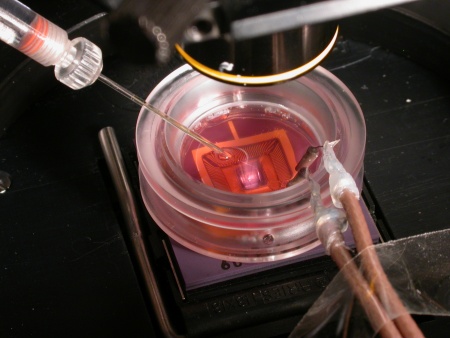 The microscope makes visible the sensor array and circuitry of Infineon's Neuro-Chip. Neurons are placed on the sensor array for further studying. Press Photo: Infineon Technologies, Max Planck InstitutePress Picture
The microscope makes visible the sensor array and circuitry of Infineon's Neuro-Chip. Neurons are placed on the sensor array for further studying. Press Photo: Infineon Technologies, Max Planck InstitutePress PictureJPG | 1.19 mb | 2272 x 1704 px
-
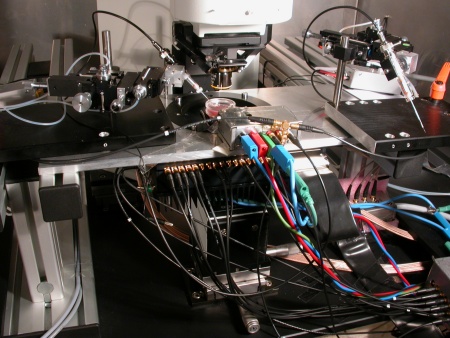 Infineon's Neuro-Chip records and amplyfies the electrical signals from nerve cells, so-called neurons, and transfers them to a computer system for processing. The data can then be transformed into a color picture for visual analysis. Researchers can detect from this data how complete nerve tissues react to electrical stimulation or certain chemical substances in a given period of time. Press Photo: Infineon Technologies, Max Planck InstitutePress Picture
Infineon's Neuro-Chip records and amplyfies the electrical signals from nerve cells, so-called neurons, and transfers them to a computer system for processing. The data can then be transformed into a color picture for visual analysis. Researchers can detect from this data how complete nerve tissues react to electrical stimulation or certain chemical substances in a given period of time. Press Photo: Infineon Technologies, Max Planck InstitutePress PictureJPG | 1.13 mb | 2272 x 1704 px
-
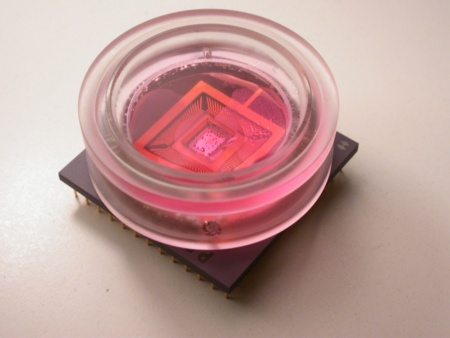 Individual neurons are placed into a nutrient solution above the Neuro-Chip's sensor array, which keeps the neurons alive and allows reconstruction of nerve tissue. Press Photo: Infineon Technologies, Max Planck InstitutePress Picture
Individual neurons are placed into a nutrient solution above the Neuro-Chip's sensor array, which keeps the neurons alive and allows reconstruction of nerve tissue. Press Photo: Infineon Technologies, Max Planck InstitutePress PictureJPG | 353 kb | 1600 x 1200 px
-
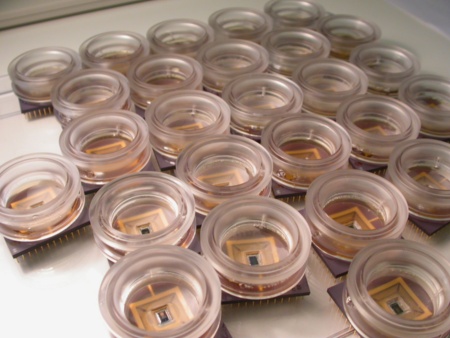 With 16,384 tiny sensors packed into one square millimeter and surrounded by processing circuits, each of these "Neuro-Chips" will be used to monitor the electrical activity of living nerve cells. Researchers at Infineon Technologies and the Max Planck Institute for Biochemistry developed the technology to gain insight into basic biological functions. Press Photo: Infineon Technologies, Max Planck InstitutePress Picture
With 16,384 tiny sensors packed into one square millimeter and surrounded by processing circuits, each of these "Neuro-Chips" will be used to monitor the electrical activity of living nerve cells. Researchers at Infineon Technologies and the Max Planck Institute for Biochemistry developed the technology to gain insight into basic biological functions. Press Photo: Infineon Technologies, Max Planck InstitutePress PictureJPG | 377 kb | 1600 x 1200 px
